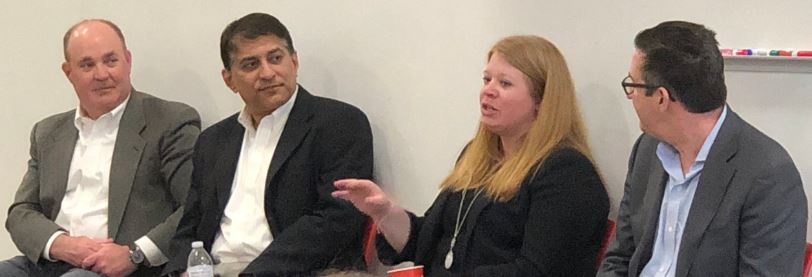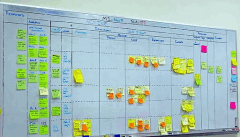Yesterday I attended a panel discussion organized by Agility@Scale in Central Ohio. This group focuses on “challenges when you scale agility in enterprise”. This particular panel discussion discussed some of the challenges that many people ask me about in training classes: capacity planning. Can a large enterprise create a sustainable product with a proper funding model while still managing demand and capacity, but also create a culture of learning and creativity?
The members of the panel were
- Steve Farley, Vice President, Information Technology at Nationwide Insurance
- Sanjay Chhabria, Vice President, Software Engineering, Pharmaceutical Segment at Cardinal Health
- Erin Karabinus, Executive Director at JP Morgan Chase
- Kevin Fisher, Associate VP, Lean Process Management at Nationwide Insurance
Manisha Mahawar moderated The event at The Point at Otterbein.
The Point at Otterbein is an absolutely outstanding facility. I visited the booth at MakerX recently where students showcased the facility, however, today was my first visit. The space elegantly combines co-working, event space, academics, and a maker-space in a gorgeous 61,000 sq. ft. facility. Be sure to take the time to visit if you have the opportunity.
Here are some of my key takeaways from the discussion:

Steve Farley, Sanjay Chhabria, Erin Karabinus, Kevin Fisher
- The panel pleasantly surprised me with their transparency of their journeys. I was also able to relate some similarities in my own large-scale delivery efforts.
- A couple books inspired Steve. He mentioned a few times: namely Project to Product: How to Survive and Thrive in the Age of Digital Disruption with the Flow Framework by Mik Kersten and The Servant Leader by Ken Blanchard
- Funding was a subject in most of the discussions. Overall, Nationwide is no longer funding teams based on demand. They are focusing on funding the work, or the effort, and team demand is pulled as needed. Human Resources issues arise most frequently in these scenarios. For example, some performance reviews and merit increases are based on funding the team. However, Nationwide is addressing these issues in other ways that make sense.
- Sanjay feels that Cardinal is definitely empowering teams to be self-organizing. However he admits that they are still not as autonomous as they need to be; they depend on each other to succeed. He supports this argument with the long sprint cycles (6-8 weeks), lack of T-shaped developers, and heavy planning sessions. Small margins are the reasons for the long planning period. However, he sees improvements taking shape to change all these aspects of the business.
- Most agreed that de-coupling products into shippable units can be challenging for a business that has been around for several years. Increasing the collaboration between these teams that need de-coupling to make them more cohesive meets this challenge. Questions arose for how to address teams and products needing to use the same data stores. Nationwide, for example, met this challenge by identifying the correct people to work next to each other to collaborate on problems like data mapping, data analysis, and data transformation. This way the business identifies the business need, in this case, data consolidation. However, the people who work with the data daily solve the problem through increased collaboration.
- Establish Change Management early when considering capacity planning. Successful teams were able to know quickly what works and what does not with Organizational Change Management or a change board in place.
- The discussion barely touched
scaling frameworks, however, LeSS seemed to be a more successful choice over SAFe. - Some confusion arose in the room over how intelligence emerged: bottom-up or top down? The panel seemed to reach an agreement that intelligence came from all around. It was not necessarily from the top or bottom of the organization. The top of the organization drove behaviors, and the teams pulled principles from these behaviors to generate business value.
- I got the sense that all groups were still working on creating a learning culture. These cultures were always improving. Some ways that the cultures were succeeding were to create communities of practice within the organizations. Others created product learning opportunities for the organization. For example, if someone wanted to learn about 401k products or annuities, they could attend an information session on such topics.
- There was little discussion on tooling for capacity management, which made me happy. In fact, the group did not reach a consensus on the tool-sets for capacity planning. Clairty was mentioned, some Atlassian toolsets for demand story mapping. However, several times Excel was mentioned as the financial planner of choice.
I’m grateful that I got a chance to attend the session. I look forward to another session for the At Scale Meetup.



